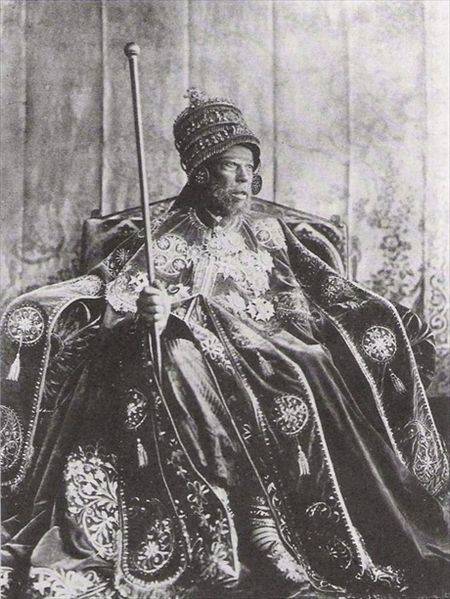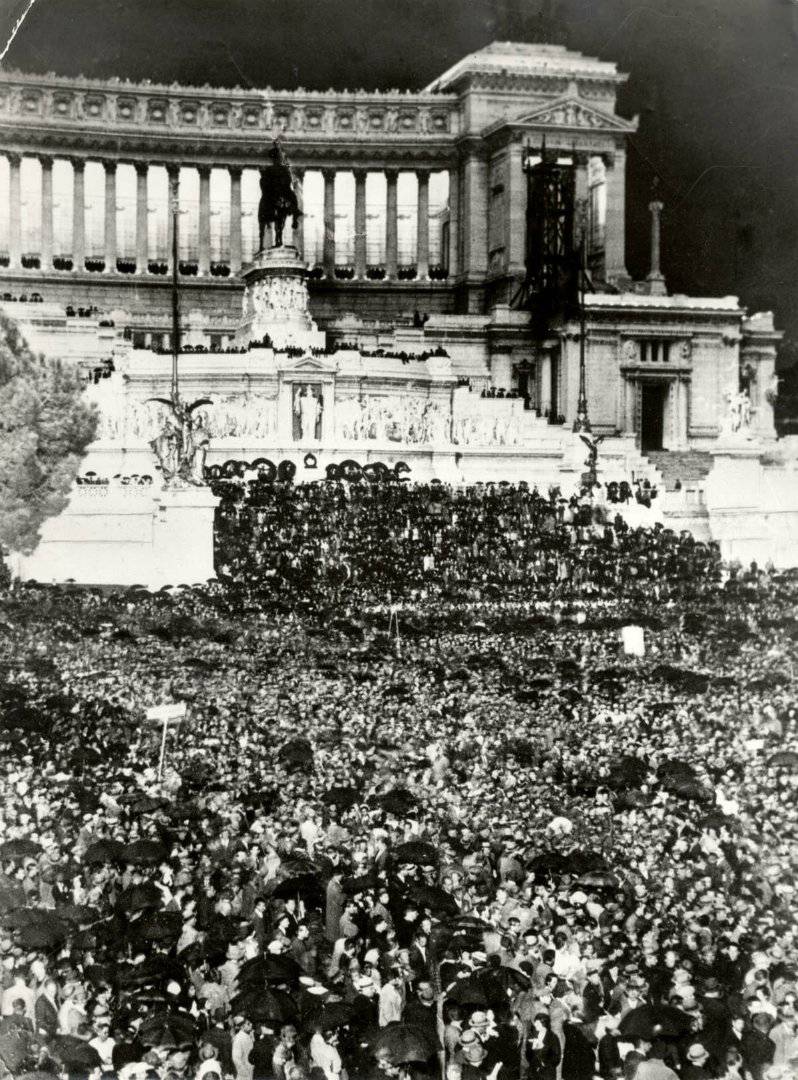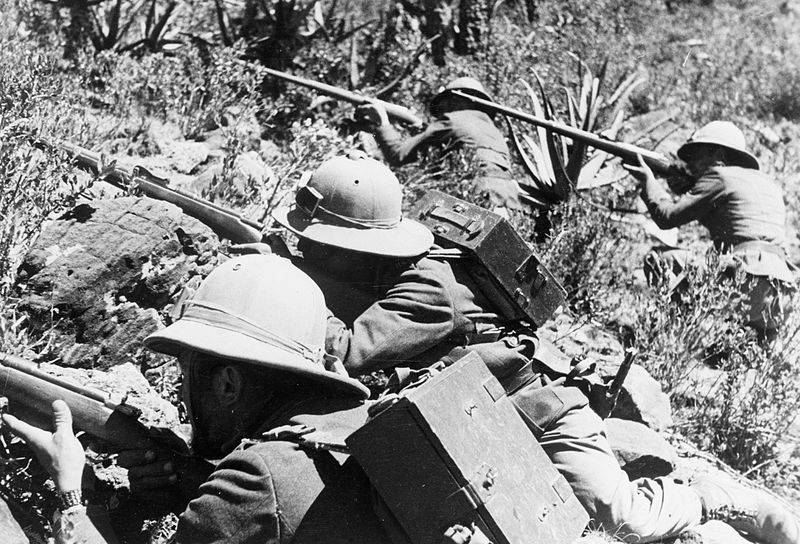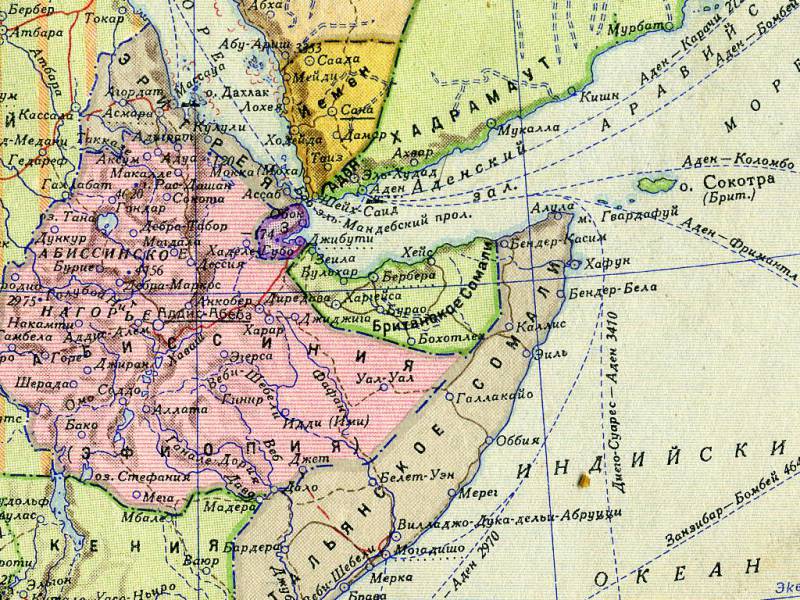How Italy conquered Ethiopia
The world community (the West) not only did nothing, but contributed to Italian aggression. In fact, the Anglo-Saxons "fed" Ethiopia in Italy. The United States immediately announced that they would not sell weapon and equipment to both warring parties. For Italy, this ban did not matter, as it had its rather developed military-industrial complex and the support of the powerful industry of Germany. As a result, it was a blow to the defenses of Ethiopia only. The United States also voted at a meeting of the League of Nations against a proposal to close the Suez Canal for Italy - the main communication of the Italian forces, without which it could not effectively fight in East Africa. Britain, which de facto controlled Suez, also did not close the channel for Italian ships. France also ended up in this camp when the French colonial authorities in Djibouti refused to transport to the border of Ethiopia and then detained the cargo with weapons ordered by Addis Ababa. Britain and France proposed a plan of "settlement": Ethiopia had to give up part of its territory and sovereignty in favor of Italy (to accept Italian advisers, to provide exceptional economic benefits). It is clear that Ethiopia has abandoned such a peaceful plan.
Only the Soviet Union resolutely defended the independence of Ethiopia, although it did not have diplomatic relations with it. However, the proposals of the USSR on the blockade of the aggressor in the League of Nations did not pass. The League of Nations recognized Italy as an aggressor and imposed partial economic sanctions. But at the same time, the embargo did not extend to a number of strategic materials; not all states joined the sanctions, and Italy could buy the necessary materials through third countries. Among the countries that refused to break economic ties with Italy and actively supported it economically, the USA, Germany, Austria and Hungary were distinguished in terms of supplies. Thus, the leading Western countries were either indifferent to the aggression of Italy or supported it.
In this war, the Italian troops widely used the prohibited chemical weapons: mustard and phosgene. The war in Ethiopia is considered the forerunner of the Second World War (along with the Spanish Civil War and Japan’s invasion of China). Victory in the war made Mussolini one of the most prominent and significant figures in European politics and showed the power of "Italian weapons." As a result, Italy overestimated its strength and attempted to continue the conquests by engaging in a war with Greece, however, the Greeks beat the Italians. Greece could only be taken in April 1941, when Germany entered the war.
The occupation of Ethiopia lasted only a few years. Immediately began the partisan movement, which brought the Italians great problems. Separate units of the Ethiopian army also continued to resist. In response, the Italians unleashed mass terror. Hundreds of thousands of Ethiopians died. This struggle continued until 1941, which forced Italy to hold large military contingents (about 110 thousand people) in Italian East Africa. In January, the British launched an offensive on 1941: from Kenya through Italian Somalia, from South Yemen through British Somalia and from Anglo-Egyptian Sudan. The British began to crowd the Italians and in 25 March they took Harar - the second largest city in the country. In the future, the British attacked with the support of the Ethiopian troops. The Ethiopian troops, formed by the Italians, also began to go over to the side of Emperor Selassie. In early April, fighting began in the metropolitan area and on April 10, the Ethiopians beat Addis Ababa. The Italians began a retreat to the north, in the mountains of the Aladzhi massif. 6 May 5 the emperor returned to the capital. By the end of the year, the Italians finally abandoned Ethiopia. True, the British remained in Abyssinia until 1941.
prehistory
Abyssinia (Ethiopia) was an ancient state that has existed in various forms since the early middle ages. In the twelfth century the Christian principalities united. In XIII Abyssinia was led by the Solomon dynasty, which, according to tradition, led the beginning from King Solomon, the Queen of Sheba and their son. This dynasty rules until 1974 year. In the heyday of the Ethiopian empire united the territories of modern Ethiopia, Eritrea, Eastern Sudan, Southern Egypt, part of Yemen and Saudi Arabia.
Christian Abyssinia survived the period of Arab and Islamic aggression. Ethiopia was also the only African state that retained independence during the colonial expansion of European states. At first, Ethiopia survived the onslaught of the Portuguese and the Jesuits, who introduced Catholicism. Then Ethiopia successfully withstood the onslaught of Egypt and Sudan, survived the British invasion.
Since ancient times Abyssinia has occupied an important place on the way from Europe to Africa and further to India and China. With the construction of the Suez Canal this value increased. Especially for England - the imperial path to India and other colonies, as well as France - to Indochina. Therefore, the Europeans seized the coastal lands of Ethiopia. England occupied the areas of Suakin, annexing them to Sudan, and British Somalia. France occupied French Somalia with its capital in Djibouti. Italy captured Eritrea and Italian Somalia. In the north and northeast, Abyssinia bordered on the Italian Eritrea; in the east, with French and British Somalia; in the south - with Italian Somalia and British East Africa (Kenya), in the west and north-west - with Anglo-Egyptian Sudan. Thus, the Abyssinia was cut off from the sea and sandwiched between European colonies.
1880-ies occurred the first collision with the Italians. 1889, between Italy and Ethiopia, concluded the Uchchial Treaty, in which the Abyssinians recognized the transition to the coastal Italians. In 1890, Italy united all its possessions in the Red Sea to the colony of Eritrea and announced that Ethiopia had recognized the Italian protectorate of itself over the 1889 treaty of the year. Almost all of Africa during this period was already divided between the European powers and Italy, which recently became a single state and was late to the section of the "African pie", hoped to seize resource-rich Ethiopia and make it the core of its colonial possessions on the Black Continent. Ethiopia was in the stage of feudal fragmentation, the power of the emperor over the largest feudal lords was conditional. Also behind the back of Italy was Britain, which supported the aggression of the Italians. Therefore, the Italians underestimated the enemy and presented this colonial war with an easy walk. And the Abyssinians were innate warriors, stubborn in battle and skilled in hand-to-hand combat. For its centuries-old history Abyssinia has repeatedly emerged victorious from the ordeals, without losing the state and military traditions. In addition, before the beginning of the war, the imperial throne was occupied by Menelik II, who proved himself to be a skilled statesman and commander. He made a great contribution to the unification and economic development of the state, and also expanded the borders of Ethiopia in the south and southwest.

Ethiopian Emperor Menelik II
The new war began in 1894. In this confrontation, Russia provided diplomatic and partly military support for Abyssinia. Ethiopia made a good move by establishing friendly relations with the Russian Empire and breaking the diplomatic blockade. As a result, Russia assisted in the modernization of Abyssinia. Thousands of Russian volunteers visited Ethiopia. In particular, Alexander Bulatovich was a military adviser to Menelik. Russia, like France, helped Abyssinia with arms and ammunition, but unlike the French, it was donated.
Back in 1894, an expedition of Yeliseyev and Leontyev was organized in Abyssinia with the aim of establishing diplomatic relations and offering assistance in organizing the army. As Leont'ev noted in his diary: the idea of the campaign gave birth “from the desire to show the whole world that we, Russians, can serve our homeland, and without resorting to fire and sword, just as well as the British, French and Germans, who made themselves strong with these two factors nests in Africa. " The sympathies of Russian society were on the side of the African country where Orthodox Christians lived. Also, Russia, which had no colonies, planned to get a reliable ally in Africa. In Ethiopia, the Russians were greeted with joy and sent back an embassy. Thus, friendly relations were established between the two Orthodox countries. Therefore, when the war began, Nikolai Leontyev was in Abyssinia with a group of volunteer officers. They occupied an exceptional position under the Ethiopian emperor. The Ethiopian Negus ("the king of kings", the emperor) received from the Russians all the data on the issues of modern European tactics and strategy, and with their help corrected his policies with foreigners. Russia in 1895 secretly supplied Abyssinia with firearms and cold arms, ammunition. After the war, the efforts of Leontyev began the formation of the regular Ethiopian army. Russian volunteers and advisers continued to help Ethiopia until the First World War.
Italian troops captured a number of cities and occupied the Tigre area. Ethiopia mobilized 100-th. the army and in December 1895, the Ethiopian troops defeated the Italians. 1 March 1896 The Ethiopians inflicted another major defeat on the Italians. The rout was complete: the Italian army from 17,7 thousand people lost about 15 thousand soldiers killed and prisoners and all the artillery. Having suffered a serious defeat, the Italians went to the negotiations. Russia supported the peace talks. In October, 1896 was signed peace in Addis Ababa. Italy, paying the indemnity, recognized the independence of Ethiopia. The northern border of Ethiopia was established. For the first time, a European power paid an indemnity to an African country. Therefore, in Europe for a long time joked at the "tributaries of Menelik." It should be noted that the successes of Ethiopia (largely associated with Russian support) stopped the British advancement in this region and forced Britain to choose a new target for aggression - the Boer republics.
Negus Menelik formally ruled until 1913 (in 1903, the Ethiopian emperor fell seriously ill and actually withdrew from the administration of the country) and left Ethiopia the only independent state in Africa (if not counting Liberia). Emperor Iyasu during the First World War retained the neutrality of the country. But Ethiopia adhered to the pro-German orientation, hoping to gain advantage in the fight against the British, French and Italians.
Map of the Ethiopian Empire of the Beginning of the 1930-s
Towards the Second Italian-Ethiopian War
After the First World War 1914-1918, which Rome joined in hopes of wide territorial increments, Italy had nothing to boast. The Italian colonial empire consisted of desert, not possessing obvious resource rich and poorly populated - Eritrea, Italian Somalia, Libya, taken from Turkey and the Dodecanese in the Aegean Sea. The dreams of the Italian leadership and the big bourgeoisie about wide acquisitions at the expense of the colonies of Germany and the Austrian possessions in the Balkans did not come true. As a result, in 1935, France and England owned more than 70% of Africa, while Italy owned slightly more than 5%.
Internal problems and the economic crisis pushed Italy to further the implementation of the colonial program. Italy needed resources, lands for colonization, needed victories to channel the energy of disgruntled masses. Therefore, Benito Mussolini, who came to power in 1922, and the Italian fascists retained the colonial program and theoretically developed it. Now Italy was considered the successor of the Roman Empire and its spirit, and had to achieve dominance in the Mediterranean, in North Africa, up to Abyssinia in the east and Cameroon in the west of the continent. Thus, not satisfied with the division of the African colonies after the 1914-1918 war, Italy embarked on a revision of the colonial division of Africa. Rome planned to create the Italian colonial empire from Libya to Cameroon - the former German colony.
The first victim was to be Ethiopia. Firstly, Abyssinia was the only independent state in Africa, that is, the war with Addis Ababa did not threaten a direct clash with Paris or London. The British and French were not allies of Ethiopia and were not going to defend it. Moreover, Western countries have blocked the supply of arms to Abyssinia. Ethiopia itself was considered a weak adversary. A significant part of its army consisted of territorial and tribal militias, whose soldiers were armed with spears and bows.
Secondly, the capture of Ethiopia allowed the Italian colonies to combine Eritrea and Italian Somalia, which allowed creating a strong springboard for further expansion in Africa. The Ethiopian bridgehead was of strategic importance, as it influenced the struggle in the Mediterranean theater from the southeast and threatened the main British imperial path through Gibraltar, Suez, Red Sea and further to Persia, India, Singapore, Hong Kong and Australia. The Abyssinian bridgehead threatened the British trans-African railway, waterway and air lines London-Cairo-Khartoum-Kapstadt and Cairo-Baghdad-Bahrain-Karachi. Also, Italy, capturing Abyssinia, threatened the maritime communications of France with its colonies in Indochina. Thus, Ethiopia occupied important strategic positions, and its capture strengthened Italy’s position as one of the leading world powers and allowed it to expand into Africa.
Thirdly, unlike the other Italian colonies, Abyssinia was rich, had a serious resource potential. Abyssinia was to become an important source of raw materials and a sales market for Italy, also a territory for colonization, where the Italian poor could be relocated (especially from the south of the country). The Italian bourgeoisie needed super-profits, and for this they needed war and colonial seizures. In addition, the Italians wanted to wash off the shame of the previous defeat in the first Italian-Ethiopian war, when they became "tributaries of Menelik."

The crowd in the Piazza Venezia in Rome during a speech by Mussolini about the mobilization. 1935
Fourthly, the international situation on the eve of the Italian-Abyssinian war was developing favorably for Italy. Italy in 1928 entered into a treaty of friendship and non-aggression with Abyssinia, but it was a formality. When it was not possible to annex Ethiopia "peacefully," Italy set out for war. With 1932, the Italians began planning a military invasion of Abyssinia. The examples of Japan, which seized Manchuria from China, and Germany, which in 1935 violated the Versailles Agreement with impunity and embarked on the creation of full-fledged armed forces, were very close for Italy.
The Ethiopian emperor Haile Selassie (ruled from 1930), in contrast to Menelik, could not find reliable external allies. An attempt to establish friendly relations with Japan failed. They could not arm the army with modern weapons because of the resistance of the Western powers.
England, which maintained a leading position in the region, was hostile to Ethiopia. On the one hand, the strengthening of Italy in the region at the expense of Ethiopia was unprofitable for London. On the other hand, the Anglo-Saxon elite set out to incite a new world war. For this, even to the detriment of the strategic interests of the British Empire, they created three world centers of war - Italy, Germany and Japan. The damage to the vital interests of Britain in the present was supposed to pay off many times in the future. Therefore, the policy of Britain was controversial. So, the British Foreign Office made it clear to Rome that if the interests of Britain in relation to Lake Tana and the Blue Nile River were not affected, England would not interfere with Italy. A similar thought was expressed by McDonalds (the former head of the British government) in an interview with Mussolini. Duce asked how London would react to the fact of the invasion of the Italian army in Ethiopia. The Laborites ’leader cynically replied:“ England is a lady. Women like actively offensive men, but subject to secrecy. Therefore, act tactfully, and we will not object. " Italians made it clear that the capture of Ethiopia is recognized.
At the same time, London began extensive military preparations in the area of its main communications in the Mediterranean and Red Seas and spread rumors about the possibility of closing the Suez Canal for Italy. In response, the Italian government stated that sanctions, especially oil, mean a declaration of war. Benito Mussolini threatened England by putting forward the slogan of reviving the "Great Roman Empire" on the corpse of the British lion. As a result, the British threat was not realized when the war began. Although, as future events of World War II showed, Britain had every opportunity to stop the aggression of Italy.
France also untied the hands of the Italian aggressor by entering into an 7 January 1935 agreement with Rome. According to him, in exchange for supporting the positions of France in Europe, Italy received several islands in the Red Sea and the right to use the French section of the Djibouti-Addis Ababa railway to supply the Italian army. Having concluded this agreement, Italy began to transfer troops to Africa using the railway. 15 April 1935 Mussolini and Laval signed a Franco-Italian agreement to redress the French border in Africa: in exchange for concessions to France on issues of citizenship of Italian settlers in Tunisia, France gave 22 km of coastline to Bab Strait of Bab el-Mandeb. After the start of the war, this section of the coast was used by Italian troops as a springboard. Paris wanted to use the current situation to strengthen ties with Rome in order to tear Italy from Germany. Also, the French were not averse to the weakening of Britain’s position in the region, and wanted to direct the efforts of the Italians to Africa, distracting them from South-Eastern Europe, where French capital had serious economic interests. Laval later boastfully stated that he "gave him (Mussolini) this Ethiopia." At the same time, the French, according to the testimony of the American ambassador to Germany, Dodd, recommended that the Italians seize Ethiopia in parts, as they did Morocco, so it would be easier to "digest".
The United States pursued a similar policy. Back in 1934, the US government declined to mediate on the Ethiopian issue. Washington helped in every way that Ethiopia “realized that no one in the world would help her” and finally refused “exaggerated ideas about independence and agreed with the moderate demands of Italy. 31 August 1935, when the Italian invasion of Ethiopia was predetermined, the American Congress passed a law on neutrality. This meant that the Italian aggressor had a complete advantage over the victim.
Thus, Britain, the USA and France contributed to the aggression of Italian fascism, pursuing far-reaching goals to destabilize the world order and unleash a world war, as well as solving personal tasks that were far from maintaining peace.
Germany supported Italy. Hitler was quite satisfied that Italy, which at that time was still not inferior to Germany in strength and even surpassed (the Reich only began to create full-fledged armed forces and transfer the economy to "war rails"), set its sights on the south and diverted from Central and Southeast Europe . In particular, Germany and Italy had different goals in Austria. Hitler was planning an Anschluss (reunion), and Mussolini wanted to keep independent Austria. In addition, world public opinion, Berlin believed, will be attracted by the war of Italy and Ethiopia, this will allow Germany to arm more calmly.
Italy has been intensively preparing for war since 1933 and, provoking it, did not want to transfer controversial issues with Abyssinia to an international arbiter. In Eritrea, Somalia, and Libya, military infrastructure was being prepared: seaports, airfields, military bases were built and reconstructed, roads were laid. For the transfer of the expeditionary army, more than 155 sea vessels with a total tonnage of approximately 1250 thousand tons were prepared, bought and chartered. For warfare, Italy created reserves and sharply increased purchases in the United States of arms, aircraft, aircraft engines, spare parts, oil, various kinds of raw materials and goods. Other western countries also actively armed Italy. So, the French Renault plants supplied Tanks. Since February 1935, having carried out a series of private mobilization, Italy began to transfer troops to Eritrea and Italian Somalia. At the same time, Rome waged an active information war against Abyssinia, blaming the Negus for the slave trade, and demanded that Abyssinia be expelled from the League of Nations. Italy proposed transferring Abyssinia to her “for correction”. Thus, in Western traditions, preparation for aggression took place in line with the “civilizational mission” and “establishing order in Abyssinia”.

To be continued ...

Information